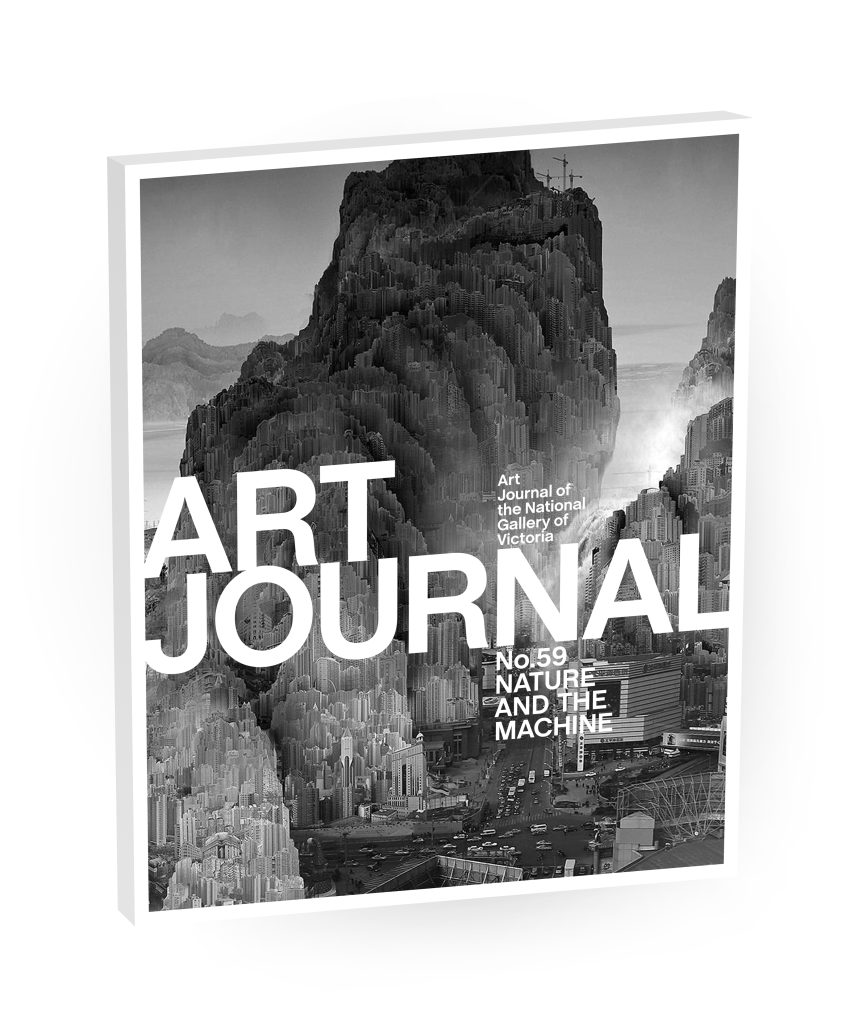This edition of the Art Journal of the National Gallery of Victoria explores the intersection of nature and technology, focusing on how stories from the NGV Collection reflect this evolving relationship. The interplay between nature and the machine has long captivated human imagination, as it represents both a source of harmony and tension. Shaped by geographical, historical and cultural contexts, the dialogue between the organic world and mechanised systems constantly shifts, reshaping our understanding of the environment and our role within it.
While interpretations of nature’s relationship with technology remain diverse, the essays in this issue delve into the ways artists have navigated and expressed this dynamic, from celebrating nature’s resilience to critiquing the encroachment of machines. These works reveal the breadth of human experience in negotiating a future in which the natural and the technological are increasingly intertwined.
Anneke Smelik positions Iris van Herpen as a designer who systematically addresses the relationship between ‘nature’ and ‘the machine’. Drawing on the theories of Gilles Deleuze and Félix Guattari, Smelik argues that van Herpen’s designs should be considered ‘posthuman’ fashion in the way that they create encounters between the organic and inorganic, craftsmanship and technology, and materiality and immateriality. Van Herpen’s works evoke a state of flux, offering dynamic representations of the human body as a hybrid entity – constantly in motion.
Through the lens of Yang Yongliang’s Phantom landscape, 2010, LeiLani Nishime explores global environmental issues, techno-orientalism and cultural perspectives of time. Yang draws on the iconography of traditional Chinese shanshui painting to create a mournful but quotidian vision of a future environmental harm in his single-channel video work. As the audience for the work shifts from China to Western nations, it risks, Nishime argues, being interpreted through the lens of techno-orientalism – an approach that imagines a dystopian future dominated by advanced Asian technology. Recognising these tropes allows viewers to challenge simplistic readings and engage with the more profound questions Yang’s work raises about time, environmental crises and the complexities of cultural narratives.
Beckett Rozentals and Raye Collins’s essay on the discovery of a Grace Crowley painting on the back of a Ralph Balson work from the NGV Collection illustrates how the use of technology can further curatorial and conservation research. The findings from this research speak to the almost symbiotic nature of the artists’ collaboration, and how that collaboration manifested in various aspects of their practice.
Ted Gott’s study of Jean Ipoustéguy’s Death of the father, 1967–68, offers a complex exploration of decay and renewal. Using marble, bronze and stainless steel, Death of the father depicts the physical decline of a clerical father figure, observed by a sculptor-son embodying a potent life force. Unpublished archival materials, including dolphin-inspired sketchbook drawings, reveal new layers to the work’s conception, inviting a fresh examination of the artist’s process and the controversy that surrounded the work’s arrival in Melbourne in 1972.
Kapua Gutchen, Garrick Hitchcock and Ian J. McNiven explore how Torres Strait Islanders of Far North Queensland have long expressed their maritime identity through a deep connection with the sea. This long history of sea voyaging was based on, and illuminates, complex, multisensorial and intergenerational knowledge systems. This essay reveals a lesser-known aspect of Torres Straight Island maritime history regarding long-distance voyaging along the north-east coast of mainland Queensland. Drawing on visual sources from the NGV Collection and diverse oral histories, the authors argue that Torres Strait Islander sailors used their knowledge of the seas to capitalise on European maritime ignorance, salvaging and repurposing the enigmatic flotsam from ships that were lost in these waters.
We invite you to explore these fresh and thought-provoking perspectives on works in the NGV’s diverse collection. We sincerely thank our contributors for offering original scholarship and valuable insights into the pieces discussed in this issue.
Myles Russell-Cook and Dr Maria Quirk, Editors
